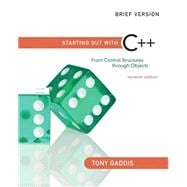This book includes the first 15 chapters from the best–selling Starting Out with C++: From Control Structures through Objects, and covers the core programming concepts that are introduced in the first semester introductory programming course.
MyProgrammingLab for Starting Out with C++ is a total learning package. MyProgrammingLab is an online homework, tutorial, and assessment program that truly engages students in learning. It helps students better prepare for class, quizzes, and exams–resulting in better performance in the course–and provides educators a dynamic set of tools for gauging individual and class progress. And, MyProgrammingLab comes from Pearson, your partner in providing the best digital learning experiences.
¿
Note: If you are purchasing the standalone text or electronic version, MyProgrammingLab does not come automatically packaged with the text. To purchase MyProgrammingLab, please visit: myprogramminglab.com or you can purchase a package of the physical text + MyProgrammingLab by searching for ISBN 10: 0132926865 / ISBN 13: 9780132926867.¿ MyProgrammingLab is not a self-paced technology and should only be purchased when required by an instructor.








